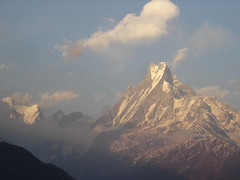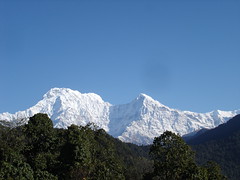Following on from last week’s post about trekking and reaching Annapurna Base Camp (ABC), Kathryn Bullock returns to share with us the key highlights and add her reflections on some of the “uncool” sides of trekking.
 Having reached ABC we opted to trek back down for lunch and continue down to Himalaya camp. The prospect of another sleepless night at subzero temperatures did not appeal as the altitude does affect your sleeping pattern. Your breath condenses on your sleeping bag and you curve the sleeping bag around your head. You know any exposed body part could freeze with everything else in the room if you leave it exposed.
Having reached ABC we opted to trek back down for lunch and continue down to Himalaya camp. The prospect of another sleepless night at subzero temperatures did not appeal as the altitude does affect your sleeping pattern. Your breath condenses on your sleeping bag and you curve the sleeping bag around your head. You know any exposed body part could freeze with everything else in the room if you leave it exposed.
As we descended the mountain we were able to thoroughly defrost and Pokhara felt almost tropical after the frozen peaks. We were then able to enjoy some creature comforts and catch up with friends in Kathmandu. Some of the highlights of the trip were:
1. The hot springs near Ginou village – A scenic tranquil spot on the river bank complete with changing rooms where you can soak your tired limbs, not to be missed.
2. Rhodedendron forests between Tadapani and Ghorepani and views from Chiule.
3. Black faced langur monkeys – watching them leap around the bamboo forests near the aptly named Bamboo camp.
4. Views from Gurung Hill – just outside Deurali and worth the short 15 min scramble up the icy path to enjoy it from the very rickety platform.
5. Views of the mountains at sunset from the Hungry Eye Guesthouse in pretty village of Landruk.
 6. Sunset views of the mountains from Tadapani as they glow pink
6. Sunset views of the mountains from Tadapani as they glow pink
7. The luxurious beds, hot showers and very friendly welcome from
Michelle and Pujan at the Courtyard Hotel in Kathmandu (PS – they didn’t pay me to say that)
8. Dancing to my favourite blues band Ashesh and Nekhvam at the Everest Irish Bar in Kathmandu – don’t miss them… more about the Kathmandu music scene in another post soon.
I’m sure I shall be returning to enjoy the warmth and friendly hospitality of the Nepali people. For those of you trying to decide which trek to do I recommend that you plan carefully before starting on the ABC trek.
 This is Visit Nepal 2011 year and the country needs your visit. The local guides said that although they have seen an increase in visitors from South Korea, they have noticed a recent decline in young trekkers due to the economic fall out across the West.
This is Visit Nepal 2011 year and the country needs your visit. The local guides said that although they have seen an increase in visitors from South Korea, they have noticed a recent decline in young trekkers due to the economic fall out across the West.
So what is not cool?
I was shocked to meet trekkers who had set off without a guide or any warm clothes or proper walking boots. The weather can change very fast with snow hiding the trail at the top and you need to have the right gear. Please see my recommended packing list for trekking.
One sight I hope will disappear from Nepal is that of the porters carrying heavy loads of 40-50 kg. They are are clearly being exploited by the large trekking companies, whose logos are emblazoned over the huge packs which tower over them. This practice exploits some of the most vulnerable Nepalis who are often not equipped with the right footwear or warm clothing for the altitude.
The porter who sits by the bridge outside Tolka who lost both his feet from frostbite is testament to the blatant disregard for porter welfare, as they can suffer from Altitude Mountain Sickness (AMS) and the cold like the rest of us. There is now a clothing bank that has been set up for porters in Pokhara where they can borrow clothing for a small fee of 15 rupees and Guru at Jomson Treks can direct any trekkers wanting to donate clothes to it.
When deciding on a trekking company, ask them about their porter policy and choose those that do not make their porters carry more than 15kg for a teahouse trek or 25kg for a camping trek, which are the standards set in Pokhara. Give your business to those companies that behave ethically.
Please share any stories you have about how porters have been treated on treks you have taken whether that’s in Peru, Kenya, or any other trekking region.
What do you think we could do to stop the exploitation of porters by the large trekking companies? Should we start to name and shame, or would it be more powerful to encourage everyone to only choose companies that have the policy set above? If you have any pictures of porters carrying too much send them in and we can help to build awareness of this issue.
Some of you may argue that it would make trekking too expensive. However, given that the small local companies are able to abide by the regulations without costing trekkers more, I can only assume the practice is there to boost profit margins.
Nepal is one of the most rewarding countries you can ever visit and the warmth of the Namaste welcome is legendary. We met several travellers who had been too long in India who were weary and wary and found Nepal such a hassle free joy to visit in comparison. I hope Nepal becomes your spiritual home like mine. Enjoy and do share your trekking stories here!
See all the pictures of the places described above and more in Nepal
 Kathryn Bullock is a frequent traveller and a social media expert and entrepreneur who has worked in the travel industry for the past 25 years. She runs Face Marketing providing social media guidance and marketing to travel and financial service companies; read her Face Marketing blog. She is also a regular blogger at Enterprise Britain.
Kathryn Bullock is a frequent traveller and a social media expert and entrepreneur who has worked in the travel industry for the past 25 years. She runs Face Marketing providing social media guidance and marketing to travel and financial service companies; read her Face Marketing blog. She is also a regular blogger at Enterprise Britain.





Kathryn, full marks from me, for highlighting the plight of porters carrying loads above safe limits. You raise a good point about naming and shaming but how about naming some of the ethical trekking companies? Better still they could leave a comment on here with their own policies and thoughts on the subject?
I’ve never been on a trekking adventure like this. I really enjoyed reading about it, especially the beautiful sights and the hospitality of the Nepali people. It’s also very interesting to learn about the exploitation of the porters. Such good advice to make sure that you’re dealing with ethical trekking companies.
Thanks Kathryn, your blog are so much informative and helpful for them how are visiting Nepal.
Bhanu adhikari
Visit Nepal Adventure Treks 7 Expedition
I enjoyed reading through this. I had never heard of the Porters until a few years ago – it is shocking to hear their lifestyles. I have heard their pay has increased, but it still sounds like it has a long way to go
Aaron
Thanks for all the comments. Like you Aaron, I didn’t appreciate the extent of this issue until recently. Kathryn highlights the issue very well and I hope this helps those who are heading out on an organised trek to ask the right questions of their tour company.
Hello Kathryn,
I hope you get this message : )
My name is Arveen Mogun from Mauritius and i’m heading to Kathmandu this 8th June 2011. I will be doing a summer course in Buddhist Studies for 8 weeks, then i’m planning to trek.
I have not yet booked any trekking trip yet as there are too many Companies offering trekking tours via the internet, so atm i’m planning to book for the trekking trip once i reach Kathmandu.
That being said, having read the above article of yours, i was simply curious, how did you organize yours, i mean, through which agency ?
And yes, your page about the Annapurna Base Camp Nepal Trekking Trip 2011 is a MOST helpful to me right now. Thank You very much.
If you wish to contact me, please do leave me a message on facebook(arveen kurt logan), from there i will provide you with my e-mail address, if that is ok with you.
Take care,
Arveen : )
Thanks Kathryn for an insightful read. I visited Nepal last year and have indeed found my spiritual home there I am writing a book about Nepal and will be sure to include the same about the treatment of Porters. Incidentally, at Chitwan I found the guides there lacking in decent footware and it concerned me. I also get irritated by these people who aim to ‘do’ a trek and ‘conquer’ Mt Everest without any regard for the delicate environment or gentle spirituality which is what the coutry is really about.
I am writing a book about Nepal and will be sure to include the same about the treatment of Porters. Incidentally, at Chitwan I found the guides there lacking in decent footware and it concerned me. I also get irritated by these people who aim to ‘do’ a trek and ‘conquer’ Mt Everest without any regard for the delicate environment or gentle spirituality which is what the coutry is really about.
Dear Arveen,
In answer to your questions I organised my trek with Guru at http://www.jomsomtreks.com. They are very helpful and their guides are very experienced. I would suggest going to see them when you get to Pokhara or emailing them beforehand. Their email is on the website. They treat their guides and porters very well and behave ethically. I will also try to reach you via Facebook as requested. Have a wonderful trek!!
Thank you for all your kind comments. Don’t know if any of you saw the article on pages 16-17 the Sunday Times on May 22nd. It was the story of Jon Holmes having climbed the Himalayas with a picture of the porters carrying a crazy amount of weight with a joke about not trying it at home. Seemed very insensitive writing to me – they should know better! Think I’ll have to write a letter to the editor. Whether they’ll publish it is another matter. I’ll keep you posted. Kathryn
Hi Kathryn,
Thanks for such a great article, especially highlighting the conditions in which some mountain porters work in. I am the owner of Lost Earth Adventures, an independent adventure travel company that specializes in trips to Nepal and other parts of Asia.
We follow the guidelines of the International Porter Protection Group (IPPG) – an organisation dedicated to the fair treatment of porters worldwide. For anyone looking to organise a trek in Nepal I would urge people to ensure that the company provides fair treatment for porters – this includes limiting the amount of weight carried on treks, providing proper insurance and equipment to porters. A reputable company will always disclose this kind of information.
– Sarah Allard, Director, Lost Earth Adventures –
Hi Sarah,
Thanks for your note .
I have just written to the President of IPPG as I am confused as to why their weight limits for Nepal are much higher (30kg) than those set in Nepal itself which are 25kg for a camping trek and 15kg for a teatrek which are standards used by the local companies there.
I shall post whatever I find out on this matter.
Kathryn
Following my recent blogs and email communication with the IPPG I wanted to update all you good people here on 501places on you can do if you think any trekking companies are flouting the legal porter regulations. I wrote to the IPPG and Jim Duff kindly agreed that IPPG will be in communication with the local Nepal Guiding Association to see if the weight limits have changed to 25kg for the Pokhara area rather than the 30kg currently set by the Nepali government. It appears that the limits are still 30kg (allowing tourists to bring 25kg and 5kg for porter belongings).
The IPPG recommendation is to report any abuse of the porter weight limits to the company that you booked the trek with. The IPPG do publish incidents of porter abuse on their website. Their experience is that the big companies use a local operator who mouths the parent company’s ethical stance and then often scalp the porters. The only way round this is to complain to the parent company to pressure their local operator. Something the IPPG have been doing since 1997. Also a load may be huge but if it has down sleeping bags in it you have to be careful with the site of huge loads, they need to be weighed. The IPPG have lobbied for scales at park entrances with no result and on Kilimanjaro.
The view of IPPG is that the biggest change would be to have the Maoist government change the law and enforce it. IPPG is a small, entirely voluntary NGO with no secretariat and cannot enforce anything, only shame the perpetrators and inform trekkers.
It’s important to praise the companies with a good record as much as shame the ones exploiting our friends world wide.
Please visit the IPPG website above if you are thinking of trekking and want to check the guidelines to ensure your travel company are behaving ethically.
Hope that helps and happy trekking!!
P.S Can’t decide where to trek next – anyone got any views on whether Mount Kenya is better than Kilimanjaro? Some people are saying Mount Kenya is a much more scenic walk
Kathryn
Even 25kg seems quite high to be honest – in Peru, the government has set a law enforcing 20kg as the maximum, and on the Inca Trail at least they actually have two weighing stations on different days to ensure that companies are sticking to the limit.
Geoff – thnaks for your comments. It’s good to know that Peru have been successful in implementing the weighing stations – something the IPPG have been trying to do in other countries but have not had much government support which is the key to their success.